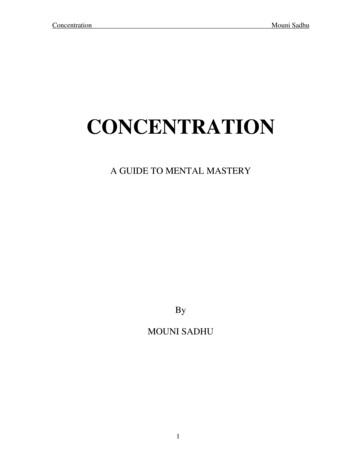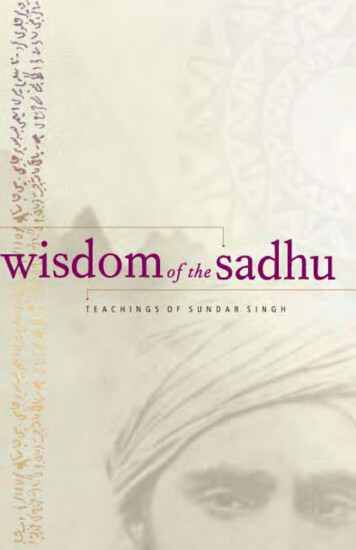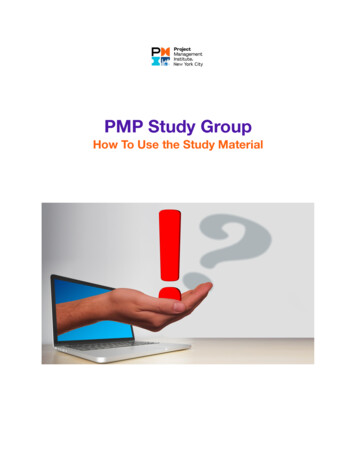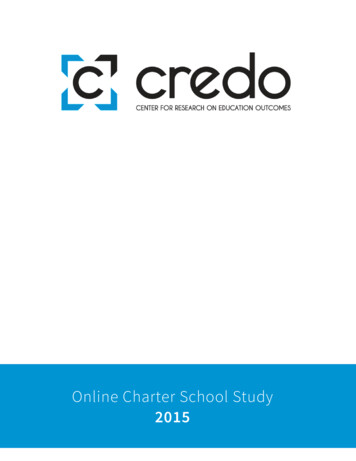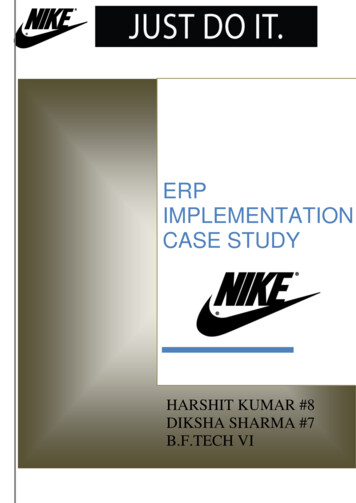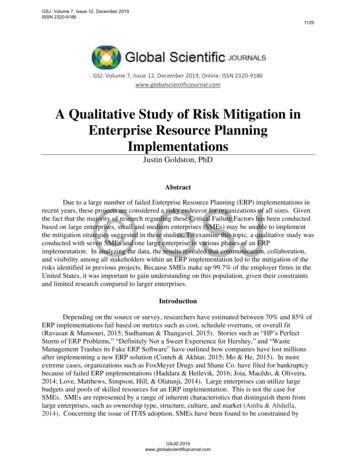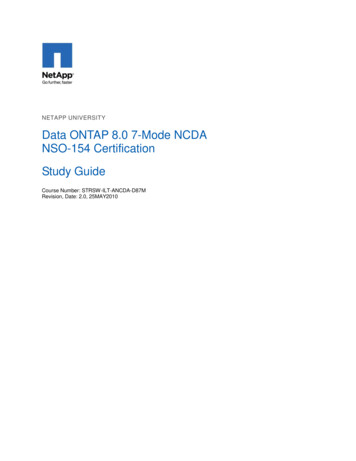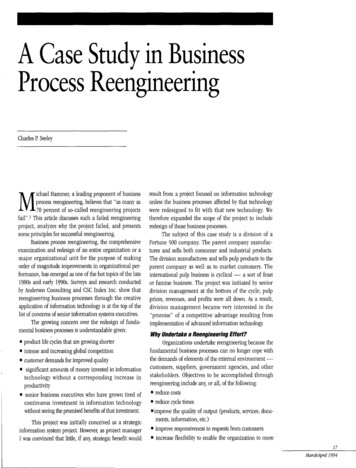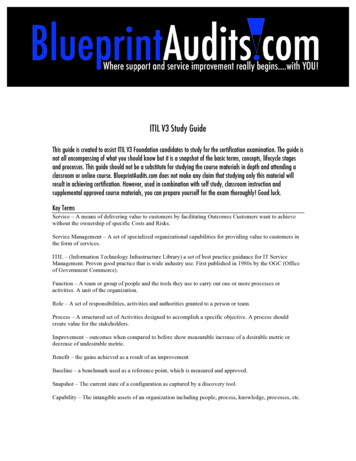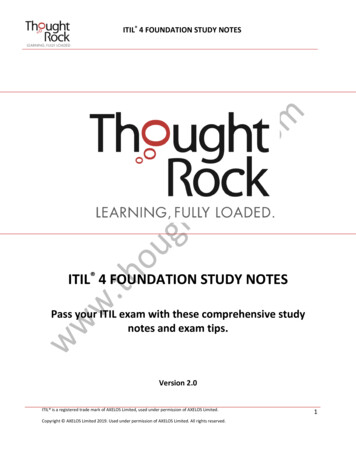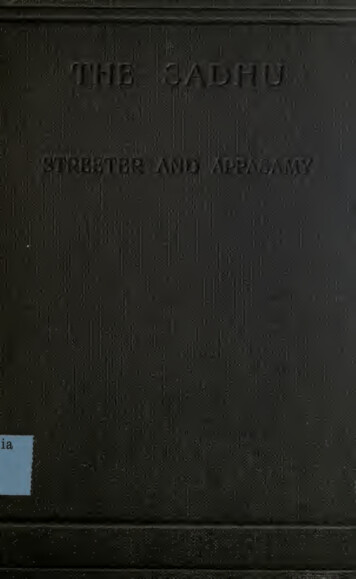
Transcription
11
MACMILLAN ANDLONDONCO., LIMITEDBOMBAY CALCUTTAMELBOURNEMADRASTHE MACMILLAN COMPANYNEWBOSTONCHICAGOSAN FRANCISCOVOIiKDALLASTHE MACMILLANCO. OFTORONTOCANADA,LTD.
-/iHJ/m-/ ifi f ir,stsiMrt;
THE SADHUA STUDYIN MYSTICISMANDPRACTICAL RELIGIONBYB.H. STREETER, M.A. (Oxo N .) HON. D.D. (EoiN.)FELLOW or QUEEN'S COLLEGE, OXFORD ; CANON RESIDENTIARY or HEREFORDEDITOR or 'FOUNDATIONS,' 'CONCERNING PRAYER,' 'IMMORTALITY''THE SPIRIT,' 'GOD AND THE STRUGGLE FOR EXISTENCE'A.J.APPASAMY,B.A. (MADRAS),B.D. (HARTFORD)J. S.M.A. (HARVARD)WELLES FfLLOW OF HARTFORD THEOLOGICAL SEMINARYMACMILLAN ANDST.CO.,LIMITEDMARTIN'S STREET,LONDONi92i
COPYRIGHT
CONTENTS.INTRODUCTIONI.THE MAN ANDInAchievementII.AMAKINGHISQuest of PeaceofAChristocentricTheVisioniSadhuWorld Fame.MYSTIC'S CREEDThe TrinityThe AtonementMysticismIncarnationviiTheConvert andMaturityPAGE:49aMystical Union with Christ.III.ATheAMYSTIC'STheGodPeace of-The DarkIV.MYSTIC'S PEACENight of the Soul.WAY84The Mystic andthe PlainNecessityofBeginner'sWay.ManThe Natureand Active ServicePrayerV. ECSTASY AND VISIONRenunciationof PrayerHabitsDevotional.TheThe.109Visions of the Jewish SeersResurrection of the Body The LastEsoteric CharacterHeavenTheJudgement69Philosophy of the CrossHellOther VisionsAnThe NatureofUnique Phenomenon TheTheIdea and its SymbolDivine GuidanceAuthority of the Church The Dangers of Ecstasy.the Ecstatic State
THE SADHUviPAGEVI. SUFFERING, SIN AND t.VII.THE HEART AND THE HEAD.179A Reaction against Intellectualismof IntellectKnowledge ofVIII.Christ.NATURE AND THE BIBLEThe BookThe FunctionThe Moral ObstacleVain Enquiryof Nature.The.Bible.191Miracles.IX. TABLE TALK212The Preacher Life and HopeProvidence The Hereafter.X.ANINDIAN CHRISTIANITYServiceReligion.225Christianity and National GeniusPhilosophicPantheism Yoga and Bhakti The Sadhu IdealMoney Marriage The Christian Sadhu and theFuture.TABLE OF PARABLES AND ANALOGIESINDEX.Frontispiece.SADHU SUNDAR SINGH.257259
INTRODUCTIONBETWEEN the Mystics of anyselves thereis,past age and ourfromthe problem ofquite apartthe mystic consciousnessitself,and circumstance which noa barrier of timeeffortof the historicIn thisimagination can completely penetrate.book we attempt a study of a Mystic, with theunique advantage that he is a contemporary ofour own.He is also one of those Mystics who appeals tothe present age because it is precisely his consciousness of communion with the Divine thatimpels him to alifeof unselfish activity and themankind."Sadhu Sundar Singh "the Sadhupractical service ofasheislives in this twentieth centurypopularly calledlife which, so far as external conditions are concerned, resembles that of St. Francis of Assisi. Hisainward experienceSt.Paul, in otherssome ways,whilein othersJuliana,recalls rather, inMotherisindividual to himself.however, weIf,venture thus to speak of him and them together,it is notby way of asserting a comparison of greatit
THE SADHUviiinessit is;merely to indicate an identity of type.a great man in thesense in which History employs that term, HistoryIn that sense no man can bealone can decide.Whether Sundar Singhpronounced greateven then by hiswe do not suggestplane withSt.ended, norBut whilecontemporaries.tillownisthat theFrancis orcareerhisSt.ison the samePaul, we feel that, fromSadhuishaving known him, we understand them better.The Sadhu is no metaphysician, no scientist,no highercritic.Indeed hisintellectual horizonmany respects nearer that of the New Testament writers than that of the modern worldisinhis intuitive insight into moral andIt is this directness and simreligious values.but so alsoplicityuponisof spiritual perception which impresseswho have been in close contact with himallthe conviction that he has a messagenot onlyto his own countrymen, but also to the West.The mannerof his teaching, even more than itssubstance, has a peculiar freshness for a Westernhearer, with its picturesque abundance of illustrationapt,itsand parable, oftenunstudiedquaintspontaneity,itsbut alwaysgleams ofIt is rendered doubly effectivekindly humour.by an arresting appearance the impression ofthe turbaned head and saffron robe harmonisingsome subtle way with the deep tranquillity of acountenance lighted up by loving-kindness, andin
INTRODUCTIONixwith a vivacity of expression, and occasionallyof gesture, which somehow seems not to conflictwith, but to express, the Peace of God within.For the cold printed page to reproduce theatmosphere diffused by such a personality, oreven to transmit to others the creative impressionof his speech,iswe havesinceimpossible.his utterances,It isthemoreso,not in his nativetongue in which he is a master of expression,but in English, a language of whose subtleties hehas but small command, so that he has at timesexpress in the phraseology of conventionalreligion thoughts which to him are fresh andtoFace to face with him in private thishardly counts, hearing him on a platform itmatters more, but where there is nothing butliving.the bare writtenworditdoes materially impairthe rich impression of the message and the man.Nevertheless, though the printed page cannot dofull justicecan do something.have seen him once, and haveto the Sadhu,The many whoitthat there was much more beyond which theywould gladly apprehend, will read into it theandmemory of his manner and his presencefelt;even those tomayyet,wewhomheisonly known by hearsayhope, find something of solid value.At anyrate the attempt ought tosecure that the Sadhu's visit to theleavebehinditsomething morebe made toWest shoulddefinite,and
THE SADHUxperhaps more permanent, than the personal impressions of a fortunate minority and the passinginterest of the crowd.The Sadhu's mind is an overflowing reservoirof anecdote, illustration, epigram and parable,but he never makes the slightest effort to avoidhe appears to delight in it.We do not," he says, " refuse to give bread tohungry people because we have already givenbread to others."Hence we have constantlyfound the same material occurring in more thanrepetition;in fact'one of the written or printed authorities we have""used.has no copymouth," he says,My"andthatwehad notedrightmany sayingsowndown from hislips we afterwards discoveredto be already in print.In most cases the versionsdiffer extraordinarily little, but we have alwaysfelt free to correct or supplement one version;by anotherour discretion;and, seeing thatSadhu'snativetongue, we haveEnglish is not thenot infrequently ventured on emendations of aatpurely verbal character.was only when we had begun to collecttogether scattered sayings on the same topics, thatwe ourselves realised the extent to which his teachIting is a complete theology in picture form, makingwith his way of life and his mystic experienceAnd if this book has anyan organic whole.
INTRODUCTIONmerit beyond fidelity toitfact,xilargely consistsand bring out this innerThis has necessarily inunity and coherence.volved much rearrangement of materials and thebringing together into the same context, occasionally even into the same paragraph, of sayingsoriginally spoken on different occasions or derivedby us from different sources. We have thoughtin theattempt to seizeitnecessary to indicate in the text the exact sourceof our information only in the case of importantBut wherever phrases likeor disputable facts."we asked " or "he told us " occur they implythat at least one of the authorsthe Sadhutionsare,was present whenmadethe particular statement ; asserhowever, often made on this sameevidence in contexts where the insertion of thepersonal pronoun would have seemed intrusive.Mr. A.meJ.Appasamy, whoin this study, is amembercollaborates withofmy ownCollegeand spending fourwho,graduatingininthe United Statesyearspost-graduate studyof America, is now engaged in research upon therelation of the Mysticism of St. John to that ofthe Hindu Bhakti Poets. During the week whichthe Sadhu spent in Oxford last February, he wasin Indiaafterincontinual contact with him.Subsequently,when we had conceived and had commendedtheSadhu the ideahisteachingmight betopermanent record ofof real value towardsthat a
THE SADHUxiiup and consolidating the results of hisEngland, Mr. Appasamy lived with theSadhu for about a fortnight in London and Paris,asking questions and making notes, and wasfollowingvisit topresent at the interviews which he had withvarious distinguished persons.One such interview was of particular value for our purpose.Baron von Hiigel, who had read Mrs. Parker'saccount of the Sadhu, put to him a number ofcarefully prepared questions suggested by his unrivalled knowledge of the literature of Mysticism ;and he was so good as to write us a memorandumon certain aspects of the Sadhu's philosophyand religion, and subsequently to discuss themwith us by word of mouth.Imyself had personal talks with the Sadhuand heard him address meetings both in Oxfordand in London and last May, just before leavingfor America, he came again to Oxford and stayed;meCollege for the express purpose ofFor the greater part of adiscussing the book.ofour questions andheansweredcoupledayswithinproviding us with muchanaccount of his mysticalmaterial, includingthetobest of our belief, hasexperiences, which,never been made public before.poured outhis ideas,In order to secure unity of style and presentation, it was arranged that the final rewritingof the book should be inmyhands.Butat
INTRODUCTIONxiiievery stage, including even the final revision ofthe proofs, my collaborator and I have workedharmony and co-operation, and it isimpossible to say of the book as a whole that itisany more the work of the one than of thein the closestother;it isin every sense a joint production.was the Sadhu's desire that any net profitmight accrue to the authors from this bookItthatshould be devoted to some religious purpose.Iasked him to name one, but he preferred to leavethe choice to me.MycollaboratorandIhaveagreed that it would be most appropriatelyassignedto the National Missionary Society of India.The mostconsiderable account of the Sadhuthat has so far appeared is Sadhu Sundar Singh by Mrs. Parker, of the London Mission, Trivan-dram, Tra van core, published by the ChristianLiterature Society of India, who have courteouslyassented to our reproducing the portrait whichforms our frontispiece.By the author's kindpermission we have to some extent drawn uponthis valuable source of information.But, partlybecause her book has been already so widelycirculatedboth in England and America, andis notprimarily bio-partly because our purposewehave, so far as possible, deliberatelyavoided covering the same ground.graphical,Nextto the notestaken of whatwe heard
THE SADHUxivfrom the Sadhu's ownour main authoritieslips,for his teaching have been three.First, the fullofhisshorthand reports of sixaddresses in thiscountry, generously put at our disposal by theNational Council of the Y.M.C.A., through thekind intervention of Mr.W.Hindlenot theonly service for which we owe him gratitude.Secondly a collection of the Sadhu's discoursespublished by the National Missionary Society ofthe nativeIndia, Madras, in the Tamil languagetongue of Mr. Appasamy. The Sadhu informedus that these were dictated by him in Hindustani,during a period of comparative leisure, to a friendwhom he relied on as expert in the interpretation of his thought.Thirdly, Seven Addresses,delivered in Ceylon and published under that titleby the Kandy United Christian Mission. Wehave also incorporated some valuable matter whichappeared in The Bible in the World and in TheForeignField,Junequotations from writingsSt.Someby Mr. A.1920.John's College, Agra, a friendoccasionalZahir, ofand devotedadmirer of the Sadhu, and by Mr. A. E. Stokes,at one time his fellow-worker, are acknowledgedwhere they occur in the text. We desire hereto express our hearty thanks to those editors andpublishers who have most generously allowed usan unrestricted liberty in making use of copyright material.
INTRODUCTIONItxvhas been our good fortune that several ofnowour Indian friendsinEngland happentohave come into close personal contact with theSadhu at different periods of his life from schooldays onward.friendswhoThese, as well as various Englishhad known him in India and else-where, have given us the greatest assistance inthe way of answering questions, suggesting pointsof view, or in reading the whole or portions ofthe book in manuscript or in proof.it isimpossible toto mention any.our obligation tonameall itFinally,But whenwould be invidiouswegratefully recordMrs. White, of Sherborne, forthe immense labour which she has bestowed uponthe correction of the proofs, and to Mr. R. D.Richardson, of Hertford College, Oxford, who hascompiled the Index.Thatthisbook should bea true interpretationof his message has, we know from his letters,The bookbeen the Sadhu's constant prayer.isfinishedbut;weare filled with a sense ofportray the man.Comingfrom the presence of Sundar Singh, men forgetbut they think ofthemselves, they forget himitsinadequacytoChrist.B.QUEEN'S COLLEGE, OXFORD,Feb.i,1921.H.S.
THE MAN ANDTHEHIScareer of Sundar Singh,India from theWestinupMAKINGto his return toSeptember 1920,Theinto four periods clearly defined.fallsoffirstwhich the latter part is marked by an ever moreand more anxious quest for Peace ends in hissixteenth year with his conversion to Christianity.The second, characterised by his adoption, as a""Christian, of the life of a Hinduholy manor Sadhu, 1 comprises seven years of variedexperience and inward growth.Atthe age oftwenty-three he was impelled to attempt, inimitation of our Lord, a Fast of forty days.Theforty days were apparently not completed, butfrom the attempt he himself dates a great acces-sion of spiritual strength and insight. This marksthe Fast as the beginning of a third perioda period of, relatively speaking,in his lifespiritual
vi THESADHU PAGE VI.SUFFERING,SINANDJUDGEMENT. . 157 KarmaSufferingSinRepentanceJudge- ment. VII.THEHEARTANDTHEHEAD. .179 AReactionagainstIntellectualismTheFunction .
